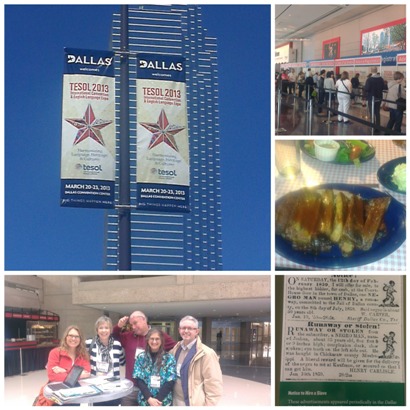|
General Impressions of the Convention
- Length: 1 preconference day plus 3 full days
- Attendance: 6,350
- Sessions: What you might expect from a conference with over
7,000 delegates and up to 30 concurrent sessions–broad. Greater variety
of session types. Lengthwise, a lot were 45 minutes long.
Initial Impressions
My initial impression of the TESOL convention proved to be a
persistent one—scale. The convention centre is the size of an airport
(not unusual, apparently, for major conference venues) while the
airport, of course—Dallas Fort Worth in this case—had the proportions of
a mid-sized town. The TESOL conference is far larger than anything
EFL-related I have encountered. There was lots to see and factoring in
the travel time to a talk became an important element of activity
planning, and I often cast wistful glances at the mobility
scooters.
The number of interest sections listed in the convention programme
isn’t very different from what IATEFL lists and calls Special Interest
Groups or SIGs—21 to 15 respectively. Unlike IATEFL, though, a
significant proportion are either sectorial (elementary, secondary,
higher ed, adult), constituency-based (nonnative English speakers) or
theme-based (social responsibility, refugee concerns). This appeared to
offer a different cross-section for talks from what I was used
to.
And when it comes to the CALL side of things—wow! The dual
attractions of having the Electronic Village alongside a hall dedicated
to CALL-themed talks was a real attention magnet for me. If you can’t go
wide, go deep!
Comparison/Contrast From My Perspective
From a CALL perspective, the Electronic Village is something
which IATEFL doesn’t have and probably won’t ever experience along these
lines. Space is always tighter in the mid-sized venues it uses. IATEFL
has a vibrant CALL strand throughout but the mainstreaming of “digital”
means learning technologies crop up right across the
programme.
Classifying sessions as research vs. practice orientated was
useful, and I found the “discussion group” format, which IATEFL doesn’t
have, provided a refreshing switch away from broadcast mode and were
great for networking.
There were many more sessions on materials creation (e.g.,
instructional design, digital publishing) than has been the case in
IATEFL. Hopefully the recent founding of the Materials Writing SIG will
encourage more of that on my side of the Atlantic.
Some of the mobile learning sessions were notable for a
tendency to showcase apps. Obviously this is useful, but I got the
impression educators were under pressure to categorize practice within
the context of a list of apps instead of the other way around. Notable
similarity to IATEFL there.
Memorable Sessions
The range of activities and minitalks on display in the
Electronic Village and technology showcase were inspirational—as much
from the evident organizational effort of maximising participation and
knowledge sharing as for the content itself.
The academic session on “Gaming and Language Learning” stood
out for me. Excellent to see a topic approached systematically from
multiple angles in one session. Luckily it was recorded
here.
The discussion groups I attended were doubly enjoyable—good content and
a welcome change of pace. Suzan Stamper and Aaron Schwartz’s session on
iPads was a good example.
What We Learned
Encouraging critical perspectives on technology
Deborah: Both the CALL-IS and LT SIG need to
do a better job of taking a critical look at technology, rather than
just making blanket recommendations, especially about mobile apps. It’s
still “Not so much the program, more what you do with it” that
counts.
Paul: Agree. We need to build in the
importance of critical evaluation in a talk selection even if the
audience is “app hungry.”
Extending the reach of the conference using technology
Deborah: The CALL-IS is doing a better job
each year with webcasting sessions at TESOL, but TESOL could do a lot
more to enable people around the world to watch sessions online. IATEFL
does a very good job of making the sessions available, with help from
the British Council.
Paul: The British Council sponsored and
managed IATEFL online is pretty amazing in scope. LT SIG is playing
catch-up with CALL-IS in livecasting its sessions. Our Liverpool
experience was very encouraging. Next year we may look to work with a
second audience in a remote venue.
Social activities
Deborah: Sponsors at IATEFL have great
evening activities for free or modest cost. The events can be ticketed
to control numbers—but publishers just don’t seem to do as much in the
evening at TESOL. Late afternoon or evening meetings that include snacks
and beverages are more fun.
Paul: Yes, Dallas was strangely quiet overall.
Ongoing Cooperation
Deborah: The interests of the CALL-IS and LT
SIG are quite complementary, and there is much that we can learn from
each other. We need to do more joint activities, building on our common
interests. The LT SIG people are a great group!
Paul: Absolutely. I really enjoyed spending
time with the CALL-IS crew. Looking forward to lots of cooperation in
the near future.

Clockwise from top left;
author’s comments: 1) Iconic View. 2) Efficient Registration Procedures.
3) I couldn’t go to Texas and not gorge on a plate of ribs. 4) Lost and
found—Old Red Museum, Dallas. 5) IATEFL guy (right) hanging around with
the locals.
Read the first part of the report.
Paul Sweeney has worked in the ELT sector for over twenty five years. In that time he has worked as teacher, trainer, instructional designer and editor. He held a number of management roles before setting up Eduworlds Knowledge Ltd - a digital learning consultancy. He is continually surprised and relieved that many of the underlying principles of good learning design which he first picked up in the mid 1990's still apply to the ebooks, apps and web materials he works on these days.Paul lived for long periods in Spain, Portugal and Italy and is now based in the UK with his wife and young son. He enjoys spending time with his family and catching up on his reading. | 
